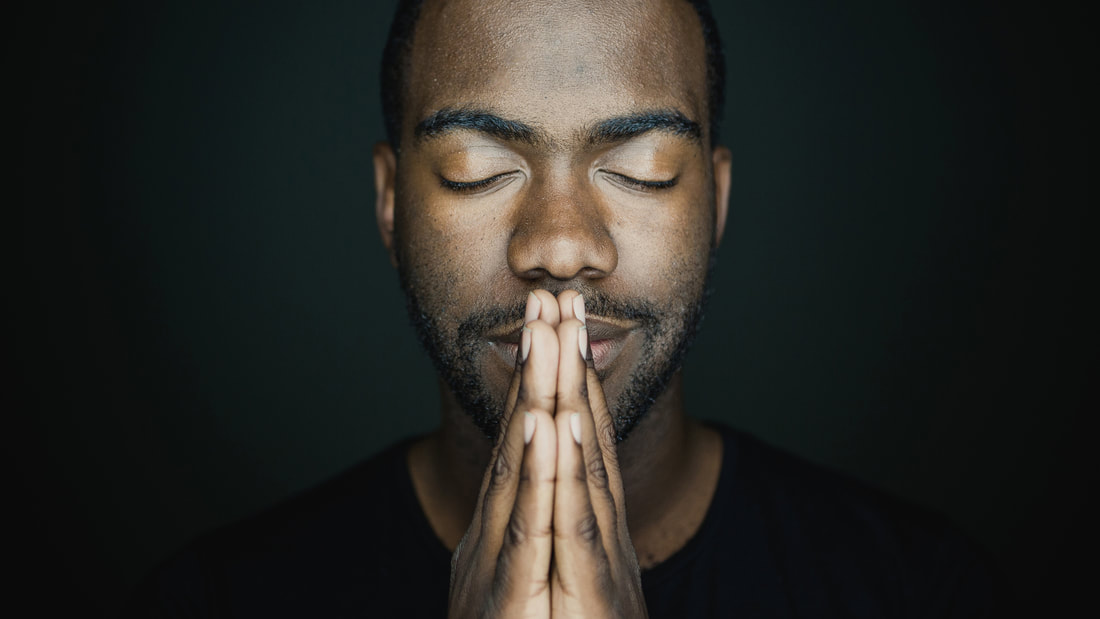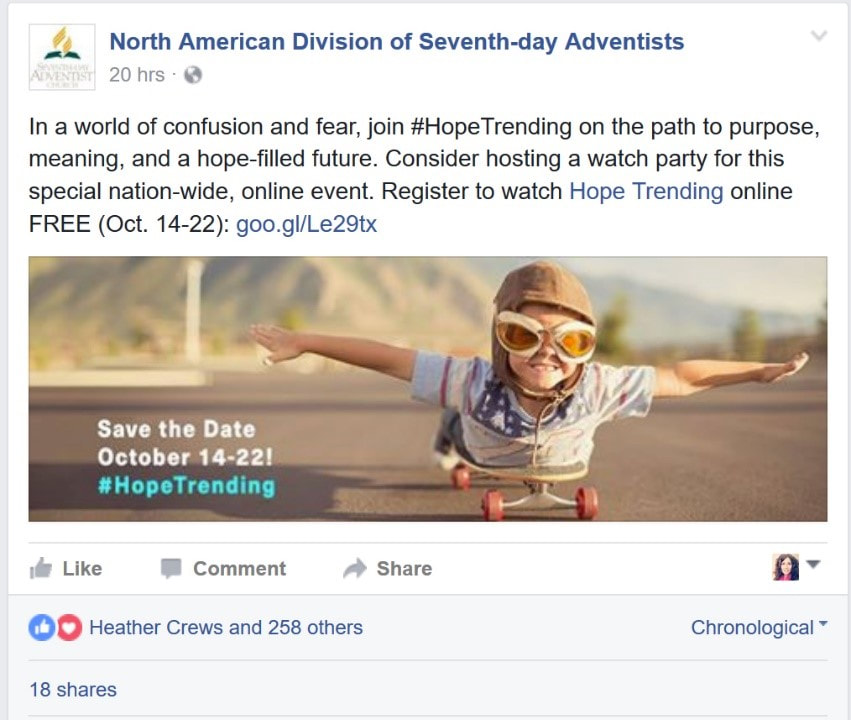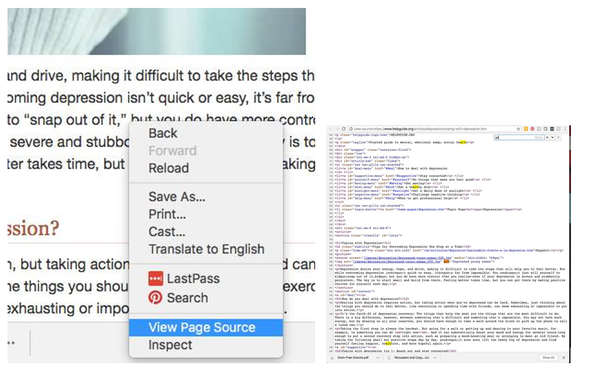Jamie Jean Schneider Domm Digital Strategist, Social Media + Big Data, North American Division  Content creation, engagement, and distribution are not limited to the official church brand and accounts. Make it a point to reach out to young people and let them know that their talents in this area are highly valued even if they are not part of the core team. Some people just need permission and a little mentorship to realize their talents and passion for personal ministry. Everyone has social influence through texting, messenger applications, email, and social media. Encourage and inspire them to use it to build God's kingdom. The two primary roles in which digital disciples can serve are as engagers and distributors. For this reason, I have decided to unpack the role of digital disciples here in the guide, in-between these two sections of the digital discipleship and evangelism model. The Bible tells us to become and make disciples. God calls us all to serve in unique ways. Ellen White encourages us to: Let every worker in the Master’s vineyard, study, plan, devise methods, to reach the people where they are. We must do something out of the common course of things. We must arrest the attention. We must be deadly in earnest. We are on the very verge of times of trouble and perplexities that are scarcely dreamed of. – Ellen White, Letter 20, 1893 Identify people in your church who can be digital disciples, all on their own, as a means to further the mission of your church. This allows and empowers members to engage in ministry and discipleship in ways that aligns with their passion, spiritual gifts, tools of preference, and personal style. There is a spiritual void online because we are not doing enough individually as members or collectively as a Church. The mission field is wide open, it’s our duty to share the gospel through the tools available to us. The Great Commission given to us by Jesus Christ states, “Go, therefore, and make disciples of all the nations” (Matthew 28:19). An easy and free way to reach the nations lies in the palms of our hands. When we hesitate to make the gospel message more available, we allow our own human weaknesses and fears to get in the way of our mission. How can we justify this resistance to boldly declaring our faith online? We live in an era of religious freedom with minimal persecution in North America (in contrast to what is happening in other parts of the world). However, the predominant perception among the Church body is that evangelism is an event run exclusively by a specific set of people. In Exodus 4:2, God asks Moses “What is in your hand?” and tells him to lead the children of Israel to the promised land. To Moses, his staff is simply a tool for directing sheep, but with God’s direction, it becomes an instrument through which miracles are performed. If God spoke to each of us today, we would answer, “a phone,” a “laptop,” or an “iPad.” Most of us have a smart phone that can be used either for distraction or for positive impact. The responsibility of every disciple is to utilize every available resource for God so at the end of the age, when we face our Master, we will hear, “Well done, good and faithful servant!...” (Matthew 25:23). We must commit to work diligently online to share present truth, regardless of who we are and what our official role may be in the Church. Tips and Ideas for Individual Digital Disciples, |
|||||||
| Download the Creating Strong Social Media Posts Fillable Workbook | |
| File Size: | 1180 kb |
| File Type: | |
Examples:
Jamie Jean Schneider Domm
Digital Strategist, Social Media + Big Data, North American Division
While learning the rules and best practices of academic or journalistic writing creates a solid educational foundation, online writing requires a completely different style and approach to get the point across as quickly, clearly, and effectively as possible.
Copy that’s written for an online audience may seem too simple, even formulaic, since this type of writing is more casual and straight-forward. However, years of research proves its effectiveness in the digital space.
Bottom line: the goal of writing online content is to connect with the reader, not elevate the author. It’s about meeting the reader where they are and giving them the information they seek, all while “desiring their good” (sound familiar? MH, 143).
In other words, it’s not about us; it’s about those we are seeking to serve. As you read through this section, remember:
Good communication is when you communicate in a way your audience understands.
9 Principles for Writing Strong Online Content
Effective online writing has at least one of the following primary goals. This is especially true for content marketing/evangelism, which requires consistent production and distribution of quality content to attract, engage, and nurture an audience.
The four purposes are:
- To inform your readers about a topic of interest, providing new information—or old information—with a unique twist, new application, or original perspective. Aimed at providing value, this type of content makes the reader feel like they’ve become more knowledgeable because of engaging with your content.
- To educate your readers with answers to their questions or solutions to their problems. This can demonstrate authority while also providing a service to your audience. Most educational article titles start with “How” or “How to” or “Learn.” You can also use videos, quizzes, courses, step-by-step guides, checklists, eBooks, white papers, handbooks, reports, and more to provide your audience with educational content.
- To entertain people who are searching for something lighthearted to pass the time, or who need a pick-me-up. This type of content can even inform or educate in a fun way, but without demanding too much brainpower. Entertaining content is often viewed while on a commute (when the reader is not the driver!), in waiting rooms, between classes, on breaks at work, while waiting for an event to start, or on the couch, winding down after a long day. Here you’ll want to utilize forms of content such as quizzes, games, polls, short videos, memes, or humorous writing.
- To inspire your readers to take an action, such as changing a habit, sharing a post, registering for your event, signing up for a free resource, supporting your cause, or donating. Inspiring content targets emotions, stirring up feelings of agitation which could be positive (excited, emboldened) or negative (angry, shocked). However, this type of content must be used carefully. Emotional content performs poorly if the reader perceives it to be overblown or insincere. Always strive to be realistic and authentic. When possible, first test your content on a smaller audience before scaling up the reach of your articles or posts.
The best online writing is conversational, yet straightforward. Think about how you’d explain something new to someone you know, and write just like you would speak (minus tics, fillers, and mannerisms).
You wouldn’t waste time on flowery, poetic words, and you’d try to relate your concept to your friend’s life. You’d be up front about why this subject might be of interest and how it could benefit them in particular. The number one reason people share content online is because they feel it will improve the lives of others. As digital evangelists, our goal should be to create sharable content that benefits the lives of others. The Church should be a leader in creating content of this kind.
In addition, you shouldn’t spend a lot of time on technical details or bells and whistles, unless you know your friend is interested in that. Instead, you’d focus on how this topic will affect them personally.
The great part of writing targeted online content is that, as long as you’re clear about your topic, your demographic will already be interested in what you're writing about! After all, they have searched for topics mentioned in your articles or posts and decided your page is worth visiting.
Since your readers used a search engine, social media post, email message, or other website to get to your content, you don’t have to worry about convincing them that the topic itself is interesting. Your job is to convince them that you have information about their chosen topic that is better, deeper, more interesting, or more applicable than other sources. Ask yourself: what will the reader get from my content that they can’t get from someone else?
Getting to your point early—in the headline, subtitle, and opening paragraph—is key.
Think about that conversation with a friend. Have you ever been in a conversation where your counterpart struggled to get to the point? They’re over-explaining the peripheral details, giving too many examples or metaphors, or trying to come up with language that softens the blow of an edgy idea or uncomfortable topic instead of outright saying what they mean.
You’d quickly realize how much time is being wasted and you’ll wish you had asked someone else to begin with! That’s how an online reader feels when the content doesn’t get to the point. They’ll click “back” and go to the next link in the search results.
Tips for writing conversationally:
- Use:
- simple, easy-to-understand language.
- words with fewer syllables. Words with more syllables reduce readability.
- “you,” “your,” and “I.” This makes it seem like you’re speaking to your audience personally.
- active voice instead of passive voice.
- examples, similes, and metaphors (but don’t go overboard).
- contractions.
- Be sure to:
- tell stories. These are easy to remember and more engaging.
- keep it short and digestible. Break long sentences into several short ones. Long sentences will reduce readability. Blog posts, for example, should be no more than 800-1,200 words.
- ask questions.
- write to your target audience.
- And, finally:
- do not ramble.
- do not ramble.
Reaching your target audiences in a deep and emotionally compelling way is key to effective communication, powerful evangelism (marketing), and creating authentic connections. In the case of mission work and cause-based initiatives, strategic placement of key words can help facilitate deeper thought and increase impact on the reader, driving them to action.
The best headlines and teaser lines receive an “Emotional Marketing Value” (EMV) score of over 40. In other words, the best online writing incorporates high impact words in a way that is quickly understood by the reader and evokes an emotional response. We are after all, highly emotional beings, who often make decisions based on what directly affects us. In a world of competing priorities and overwhelming need, this can be a useful tool to help your message stand out among the digital clutter. Afterall, your message must be read in order to have impact.
The emotional richness of copy is evaluated based on three categories:
- EMV = 42.86%
- EMV = 50% for “Feeling defeated? Marriage is hard and you're struggling. We're here for you. Join us for a free seminar.”
Remember to also boldly make your claim up front, then use the rest of your content to back it up. If the point you’re making is a bit jarring, that’s not necessarily a bad thing. Plus, by getting to the point early, you tell your audience why they should prioritize your content over someone else’s. People are busy; state the value up front and then deliver on that promise.
Consider the idea of inspiring people by agitating emotional states:
People don’t do things because they’re comfortable. People don’t do things because they’re bored. People do things because they’re excited, outraged, empowered, inspired, shocked...
- Christofer Jeschke
- EMV = 50%
- EMV = 45%
The heart of copywriting is persuading readers to take an action.
Sometimes, when we think of marketing copy, we think about those spammy e-mail subject lines that over-promise and over-guarantee, or we cringe at clickbait headlines for videos or blog posts.
Well, if sales copy puts a bad taste in your mouth, keep in mind that you’re thinking of bad sales copy. When copywriting is done conversationally, with the reader’s feelings, interests, and beliefs/core values in mind, it can be incredibly effective. Remember, people are drawn to authenticity and honesty. Church messaging should always demonstrate the highest level of integrity.
Define the problem
Throughout a piece of writing, a reader is moved to action by introducing a problem that the reader needs to solve. They want something, they’re confused about something, or they don’t know the next step in a process.
You outline the problem, describe the implications of this problem, and then give them the solution—your resource, your solution, your method, your information, etc.
Benefits vs. features
When describing how great your resources/belief/method/service/information is, don’t just list its features—describe the benefits it will provide to your reader, and why those benefits are in their best interest. People want to know why before they take the time to understand the how.
For example:
“Buy our hibiscus tea!”
Why?
“Our blend has more antioxidants.”
Ok...what does that mean?
“Antioxidants decrease free radicals in your bloodstream.”
Ok...what does that mean?
“Antioxidants keep the cells in your body from breaking down!”
Ok...but what does that mean for me?
“Well, this tea has been shown to help lower high blood pressure, according to the American Heart Association’s 2008 study.”
That sounds pretty important. How does it taste?
“Great! Especially with honey!”
Well, all right then—why didn’t you say so?
When we’re personally invested in the subject of our writing, we can get lost in the details. Remember that the readers aren’t there yet. They need to see a connection between what they’re searching for and what you have to offer.
For example:
“You’ve been diagnosed with high blood pressure, and it can be tough to give up some of the foods and beverages you’ve enjoyed for years—like coffee, black tea, and soda.”
You speak the truth. It’s like you’ve been there, man!
“But what if there was a soothing hot drink that could be just as tasty, AND help lower your blood pressure at the same time?”
Is there? That would be so helpful right now! Tell me more!
Superperfect Tea Company offers premium hibiscus tea. And, according to a 2008 study by the American Heart Association, it lowers blood pressure in pre-hypertensive and mildly hypertensive adults.
I could use that! How does it taste?
This ruby-red herbal tea has a slight tart flavor reminiscent of cranberries. Add a little honey, and it delivers a light, tangy “bite” that can pick you up in the afternoon or calm you down in the evening.
Mmm. Can I try some?
Notice how the problem was outlined in the introduction, with the primary benefits immediately following. Meet the readers where they are, then tell how your amazing product is just what they need...and why.
Now, if we frame this in the context of ministry, your product is your message, which may be hope, wholeness, health, lifestyle, truth that answers their deepest longing, answers to their physical/spiritual needs, sound advice, and more.
Calls-to-action (CTA)
Once you’ve “sold” the product by connecting with your readers’ needs, it’s time to tell them to buy it! In ministry, this may mean subscribing to your newsletter, registering for a seminar or health clinic, coming to an event, or joining a small group dedicated to a particular topic.
Don’t leave them hanging. They want to take action, and the more clear and straightforward the call, the more likely they are to follow through.
You may have already imagined a call-to-action following the last line of the hibiscus tea conversation:
“Yes! Get 20% off your first box of tea when you order now!”
or
“Yes—get a free sample sent to you now!”
Copywriting isn’t complete without a call-to-action. It doesn’t have to be overly clever or cute; it just needs to make sense. Here are the most common calls to action that appear in online marketing:
- Order now!
- Download here.
- Watch this video.
- Join today!
- Donate to [insert organization name] & get a free travel mug!
- Listen now!
- Register now and get a free [insert item]!
- Start your free trial today!
- Secure your spot!
- Get the full version!
- Access exclusive information!
- Sponsor a child today!
- Book your appointment now!
- Find out if you qualify!
To share stories is human and approachable.
There is an old Jewish parable of “Truth & Story” where naked Truth traveled from village to village trying to find acceptance and love. In each village, Truth was mocked, ridiculed and ultimately chased away. Naked Truth was hated by all she encountered. From afar, Truth saw Story, dressed in beautiful robes, enter the village that had just rejected her. The people loved Story and praised her beauty, quickly embracing her. Story later found Truth crying far outside the village and asked what was wrong. Truth revealed her desire to be accepted like Story and shared the pain of her experiences. Taking pity upon Truth, Story shared some of her beautiful robes with her so that she was no longer naked. From then on, Truth and Story always traveled together, and everywhere they went, the people rejoiced and welcomed them.
Storytelling is a powerful means of communication online because:
Stories never tell us what to think, they give us something to think about. Stories don’t tell us what to feel, they cause us to feel.
Effective writing is both a science and an art. Yes, wordsmithing is a creative process, but copywriting is a science backed by research. A great way to add creativity to the elements of formulaic copywriting is through storytelling. People can’t help but be interested in stories. As humans, we want to know how things turn out!
For generations, storytelling has been the way people learn their history and connect. The Bible itself can be viewed as a collection of stories that draw people to God, teach us difficult truths, and connect us through a shared set of beliefs. To “win” souls, we, as a Church, must connect with a person’s experiences through stories. Not only is storytelling a powerful means of communication, but a vital tool for sharing a message of hope. Jesus told parables because truths revealed through stories are an effective way to reach people with thought-provoking topics that are easy to remember. We, like Jesus, should become expert storytellers.
Storytelling connects people and gets them engaged and interested in each other. The reason why people love watching movies and reading books is because we love to be immersed in stories. Social media is people connecting with people to create a collective human story. Our job is to frame that story within the context of our faith. We can provide answers and connection online users are looking for, if we’re strategic and intentional with what we write and the content we create.
Stories can be in the form of case studies, testimonials, video retellings, or simple anecdotes that describe how a person—just like the reader—struggled with a specific problem. Maybe they tried several things until finally discovering what really worked.
Where can you find real stories? As a ministry, you might already have them. Think of the people you’ve served. Think of the events you’ve held. Think of the testimonies your constituents have shared with you. How does their journey reflect a common need or experience within your target audience?
Going deeper, what analogies or metaphors can you draw from what you do? Can it be related to common daily life concerns? How does your ministry offer practical solutions?
Check out this article on finding marketing stories in everyday life.
Write down a story that you would share with your audience that could come across as relatable and relevant to their core values or needs.
While these terms are sometimes used interchangeably, they are different. Copywriting refers to the science, the persuasive writing formulas, the headlines, and the calls-to-action. Content writing could be considered the filler content that fleshes out the formulas for content marketing purposes: the stories, the details, the background information, the educational steps, or other valuable pieces of information you’re offering your reader.
In many ways these two elements of writing overlap and work together, and both occupy vital roles in the digital evangelism process.
There are increasingly specific definitions of these two terms across the internet, but the bottom line is that these writing styles and formulas work together to provide value to the reader, persuading them to stick around and, eventually, take action.
There are two primary categories to consider when crafting your overall website content: time-sensitive content and evergreen content.
While, indeed, simple concepts, when it comes to SEO, content marketing, and user experience, there are strategies to consider in the implementation of these two content types.
Announcements, breaking news, special offers or promotions, seasonal content, and events are time sensitive by nature. It’s good to have some time-sensitive information on your website and social media—if you consistently keep it up to date. It demonstrates to site visitors that your organization is active and aware.
It is more frustrating to go to a website/profile with out-of-date information than to go to a website/profile with no time-sensitive information at all. If an event from a couple months ago is still headlining, how can the visitor trust that the rest of your information is current?
Evergreen content, however, refers to elements on your page without an expiration date. It’s static content that doesn’t change (much) over time. It doesn’t need to. It’s written to stay relevant and useful to your audience regardless of when they read it.
For general website and social media copy, this evergreen content includes:
- About
- Services
- FAQ
- Archived posts or cornerstone articles
- Resources
- Testimonials
Effective messaging, whether you are publishing content regularly on a blog, posting on social media, or sending emails, requires new, helpful content to stay fresh and up to date. However, that doesn’t mean that each piece of content must be time-sensitive. You can cultivate them to be evergreen as well as timely.
To keep new content evergreen, the key is to stick with topics rather than dates.
While some of your social media or email content may contain time-sensitive information, they can link back to an evergreen blog post that covers a related topic thoroughly and that you periodically update as information changes.
To help your posts, pages, and articles stay evergreen in SERPs (search engine results pages), try removing the publication date from your post (unless it’s necessary). For the many seekers that check the date on webpages before clicking on them in search results, removing the date altogether can help present your content as timeless.
If you’re a church posting each week’s sermons as videos or podcasts, the first priority to keep these elements evergreen is to title each one topically rather than with the date of the service (i.e., “Teaching Your Kids to Pray” vs. “Sermon 4-25-17 on Prayer”). Note that you can still show the date in the subtitle or descriptions for members that search by date, but the title should be presented like a headline.
The topics covered in evergreen content must be “enduring topics,” discussing common experiences of the human condition (job interview best practices, dealing with grief and loss), timeless skills (how to pray, how to change a tire) or opinion/discussion pieces (which translation of the Bible is best?, is it better to exercise in the morning or evening?).
Additional ideas for effective evergreen content with examples:
- Case studies (“How Pathfinders Made Me More Confident”)
- Day-in-the-life posts or videos (“Shadowing a Pathfinder Director at Oshkosh”)
- Interviews (“Joe Smith, Pathfinder Leader for 40 Years, Tells Us His Best Stories”)
- Adapted livestreams (“Pathfinder Leadership Training—What Not to Do Skit”)
- Demonstration videos (“Advanced Knot Tying”)
- Topical blog post (“7 Ways to Deal With Rambunctious Kids”)
- Topical blog series (“Getting the Most Out of Oshkosh, Part 1 of 3”)
We’ve covered the different types of content that can be created to reach a variety of content consumers, as well as what makes content “evergreen,” or relevant past its publication date.
These principles can come in handy in the beginning stages of your SEO and content evangelism strategy and when it comes to repurposing content. Instead of creating a different piece of content for each platform you publish to, you can repurpose one core content piece to work across a variety of channels.
Here's an example of how you can make one blog post explode into ten different pieces of shareable content:
You, a nationally-renowned sandwich artist, wrote a winning post for your sandwich-making fans.
- Publish blog post on your website: “5 Creative Ways to Slice Sandwiches for Dazzling Hors D'oeuvres Trays.”
- Create teasers for your blog post for your followers on:
- etc.
- Create an infographic, illustrating the step-by-step process of each fancy slicing technique.
- Put together a slide deck for further details on each step of sandwich-slicing artistry.
- Announce this fantastic post to your email list.
- You could even create an exclusive autoresponder series (emails sent automatically to a mailing list based on specific rules/or subscriber behavior at defined intervals) that focuses even more in-depth on each of the five sandwich slicing methods.
- Host a webinar or a Facebook live video about the five slicing strategies for aspiring sandwich artists, with Q&A afterward.
- Turn that webinar into an evergreen video that will live on your YouTube or Vimeo channel.
- Host a podcast, where you gather with a fellow sandwich aficionado or two and discuss these five slicing techniques.
- Type up transcripts of the podcast discussion for those who prefer to read.
- Turn your feedback into more shareable content. Are you getting lots of comments on your blog post, your social media channels, or your videos? Did anyone submit ideas or questions? Publish a follow-up post or video that showcases your followers’ pictures of their own slicing results, blooper videos, or new discoveries. Or create a quick video to share tips about part of the third slicing method that your virtual protégés are having a tough time with.
Repurposing content can allow a specific topic to be discussed online longer by spreading out the publication of each repurposed item.
Furthermore, the same topic repurposed into ten different forms (example above) can create a bigger splash as it makes its online debut. This strategy creates more options for Google to index, increasing your chances of showing up prominently in search results, and it also allows your content to show up in the search engine results for various social media platforms as well.
(Titles, Tags, and Descriptions).
While seemingly small, these more technical areas of online writing can make a big difference in how Google views your site and in convincing people to click on your webpages and content in search results.
Title Tags
Sometimes called the “SEO Title,” this is the title that appears in search engines and what is displayed at the top of a browser tab when a reader opens your page.
For example, say you want to rank for the keyword/phrase “couples Bible study” and you thought of two SEO Title choices:
- Weekly Couples Bible Study - ThisTown Church
- Looking for a Bible study that caters to new couples?
Google would rank the first one over the second one because it would deem it more relevant and topic-centric. The second one is not a bad headline (save it for your H1!) but Google favors SEO Titles that are more direct.
Editing your page title in HTML code looks like this:
<head>
<title>THIS IS YOUR PAGE TITLE</title>
</head>
Otherwise, most content management platforms have a designated space to add or change a webpage’s title.
NOTE: If you already have significant traffic coming to your page with your current page title, even if it’s not optimized for the intended keyword, you might want to check your analytics before changing it. If visitors that come in through that page are staying on your site and clicking, downloading, buying, etc., you may want to consider keeping it the same, because you don’t want to lose that current traffic. If you notice that people are coming in through this page but then leaving the site, a title change could be highly beneficial.
Meta Tags or Meta Descriptions
This is the approximately 200-character teaser-like blurb that appears directly below the SEO title in search results. Often, this is what convinces the reader that your content is valuable.
Your meta description can be as long as you want, but Google will cut it off anywhere between 250-300 characters, depending on the amount of pixels those characters occupy.
While the recommendation used to be 160 characters, Google raised the number of permitted characters as of December 2017. It was changed again in the spring of 2018, then later adjusted to the current recommendation of 200 characters. In light of this apparent state of flux, aim to keep meta tags as short as possible while including the necessary information.
For example, if you’re selling vegan, gluten-free granola bars, you might want your meta description to say something like:
VEGLUFRE—A fast, tasty, healthy breakfast option! Packed with protein, fiber, vitamins, and minerals, our vegan, gluten-free granola bars make a great meal or snack. 5 flavors! Order in bulk & save!
Make sure to connect the benefits of your product, service, or idea/cause with the needs and interests of those you hope will click on your link. List a key selling point or two, then describe what they’ll find on the page and why it matters to them.
Most content management platforms will have an area for you to enter the meta description for each page, or you can install a WordPress plugin like Yoast that allows you to edit the entire meta description.
To enter a meta description straight into the HTML, the <meta> element will always go inside the <head> element. It will look similar to:
<head>
<meta name=”description” content=”THIS IS YOUR META DESCRIPTION”/>
</head>
NOTE: Every page should have its own unique meta description. Google notices if multiple pages have the same meta description, and many SEO auditing software programs will note redundant meta descriptions as an SEO error.
H1 Tags/Headers/Headings
This element of your page doesn’t typically show up in search engine results, but it is the first thing googlers will see after clicking on the page. To make sure they stay there, devote attention to creating effective headlines. Make sure to specify what they’ll find there and why they will want to continue reading.
Include some keywords in your headers, pinpoint a benefit your content offers, and give brief hints at what the content covers.
For example:
“Can’t decide which Bible translation to use? Learn the history of the differences between Bible translations”
or
“7 Ways to Simplify Complex Recipes for Easy, Healthy Dinners”
In the example below, “Coping with Depression” is the H1 tag, demonstrating how a keyword should used in the first three words. The subtitle, “Tips for Overcoming Depression…” has specific subtitle formatting, and the subhead “How do you deal with depression” lower on the page is formatted with the H2 tag.
This will typically make the text larger and bolded, or possibly a different font, depending on the theme or template you're using.
Each page should have only one H1.
For subtitles or subheadings, which are excellent for breaking up long text blocks and making the whole post more skimmable, content managers can use H2 or H3 tags, which will typically appear smaller than H1-designated text. H2 and H3 tags do not have an SEO impact, but can enhance readability.
If you can’t get into your content management platform at the moment and want to check how a certain paragraph is designated, right click on the page and select “View Page Source” to view the HTML code. You can also highlight the area, right click, and select “Inspect Element” on Macs.
This code-level text makes images searchable by Google. Also known as an “alt attribute” or “alt description,” this HTML tag is applied to an image on your webpage. It doesn’t show up on the page, but googlebots pick it up and use it to determine the topic depth of your page.
While Google can determine several aspects about images, Google won’t always “see” the message it’s intended to illustrate or support. To understand the content of the image, Google relies on ALT tags to determine what the picture is and how well it relates to the topic of the page, which impacts your ranking.
Additionally, ALT tags provide the image information for:
- Visually-impaired googlers using screen readers
- Those who can’t see images in their email or browser (if images or HTML is disabled)
Don’t make it too long, and make sure not to “keyword stuff” the ALT tag, an old “black-hat” SEO practice that Google will not favor and possibly penalize. For example, for the same image described above on the “sermon tips” page, keyword stuffing might look like: “megaphone sermon tips project voice sermon audience sermon strategies public speaking presentation methods.”
Add your ALT text into your content management system, or into the HTML by editing the source code:
<img src=”bluemegaphone.jpg” alt=”ALT TEXT HERE”/>
For example, in the picture on the previous page about coping with depression, this is how the ALT text appeared in the source code:
Using these seemingly-minor titles and tags can not only improve your SEO but also your user experience, enticing seekers to click on your site as they comb through search results for relevant information.
In summary:
- Your title tag answers the “what” questions of seekers. What is this page? What is it about?
- The meta description answers “why” they should click on it.
- The H1 tag answers a combination of “what,” “why,” and “how” by introducing the topic and foreshadowing what the content will offer seekers or how it will help them.
- ALT text helps Google know that images relate to the subject matter, indicating a more complete page. It also helps visually-impaired people learn what your page is about and what the images are, as they can be read by screen readers.
Archives
August 2020
July 2020
June 2020
April 2020
March 2020
February 2020
December 2019
November 2019
August 2019
July 2019
June 2019
May 2019
April 2019
March 2019
February 2019
January 2019
December 2018
November 2018
October 2018
September 2018
July 2018
June 2018
May 2018
April 2018
March 2018
February 2018
January 2018
December 2017
November 2017
October 2017
September 2017
July 2017
June 2017
May 2017
April 2017
March 2017
February 2017
January 2017
December 2016
November 2016
October 2016
Categories
All
A Allan Martin
Adam Fenner
Angeline Brauer
Big Data
Center For Online Evangelism
Chris Matts
Culture
Data Science
Data Tracking
David Mwansa
Design
Digital Discipleship
Digital Pew
Digital Strategies Intern
Dustin Comm
Email Communications
Erica Jones
Event Registration
Faith-hoyt
Fundraising
General
Harvey Alférez
Heidi Baumgartner
James Gigante
Jamie Schneider
Jason Alexis
Justin Khoe
Kaleb Eisele
Kimberly Luste Maran
Marketing
Member Care
Michelle Diedrich
Nick Wolfer
Online Church
Paul Hopkins
Philanthropy
Rachel Lemons Aitken
Reaching Young Adults
Rodney Brady
SEO
Social Media
Stewardship
Text Evangelism
Video
Volunteering
Website
Working From Home
























 RSS Feed
RSS Feed